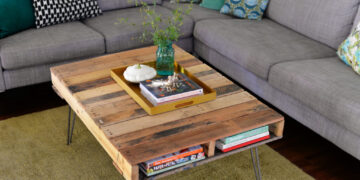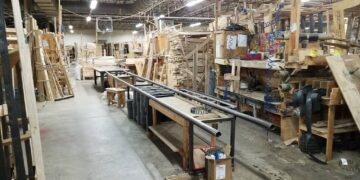From Ingenuity to Ingvar: Unveiling the Epic Saga of IKEA’s Ascendance
In today’s global marketplace, few names resonate as strongly as IKEA. Renowned for its affordable furniture and home accessories, the Swedish company has achieved a level of fame and recognition that is unparalleled in the industry.
From small beginnings in the forests of Sweden, IKEA has grown into a global empire with over 400 stores in more than 50 countries. Its distinctive blue-and-yellow branding and maze-like store layouts have become iconic symbols.
However, behind this immense success lies a remarkable story that few are aware of—a story of visionary entrepreneurship, innovative design concepts, sustainability at heart, clever marketing strategies, and efficient logistics. This article will delve deep into the captivating narrative behind IKEA’s rise to global fame.
Brief Overview of IKEA’s Global Fame and Recognition
IKEA’s name has become synonymous with affordable yet stylish furniture solutions for millions around the world. Since its inception in 1943 by Ingvar Kamprad, a young Swedish entrepreneur with an indomitable spirit, IKEA has consistently captured the imagination of consumers across continents.
What sets IKEA apart is its ability to combine functional designs with affordability without compromising on quality—an approach that resonates deeply with people from all walks of life.
Over the years, through its relentless expansion efforts and unwavering commitment to customer satisfaction, IKEA has gained widespread recognition as a leading provider of ready-to-assemble furniture products and home furnishings. Its catalogues have become collector’s items themselves, eagerly awaited by millions each year for inspiration on how to transform their living spaces into personalized havens.
Teaser about the Remarkable Story Behind IKEA’s Rise to Success
Behind every successful company lies an extraordinary tale filled with trials and triumphs; IKEA is no exception. The ascent of IKEA from a small mail-order business in the Swedish countryside to a global retail powerhouse is a testament to the indomitable spirit and visionary thinking of its founder, Ingvar Kamprad.
But the story doesn’t end there. The remarkable success of IKEA is also attributed to its unique design philosophy, innovative self-assembly concept, labyrinthine store layouts that entice exploration, commitment to sustainability, creative marketing campaigns that transcend cultural boundaries, and an intricate web of logistics that ensure smooth operations on an unprecedented scale.
This article will delve deep into these fascinating aspects of IKEA’s journey and unveil the secrets behind its rise to global fame. Prepare to embark on a captivating narrative that will uncover how this Swedish giant assembled its empire piece by piece.

The Visionary Founder: Ingvar Kamprad
Early life and entrepreneurial spirit of Ingvar Kamprad
Ingvar Feodor Kamprad, the extraordinary mind behind IKEA’s global success, was born on March 30, 1926, in rural Sweden. Growing up in the province of Småland, Kamprad displayed an innate entrepreneurial spirit from a young age. At just five years old, he began selling matches to his neighbours and quickly realized the power of commerce.
This early experience ignited a relentless drive within him to create something larger than himself. Despite facing dyslexia and other challenges in his education, Kamprad possessed an exceptional business acumen that soon led him to embark on more ambitious ventures.
By the time he turned seventeen, he started utilizing local milk truck routes to deliver goods like Christmas decorations and fish to nearby towns. This enterprising spirit laid the foundation for his future accomplishments.
The founding of IKEA and its humble beginnings in Sweden
In 1943, at the tender age of seventeen, Ingvar Kamprad founded what would later become one of the world’s most iconic furniture retailers, IKEA. The name “IKEA” is an acronym derived from his initials (I.K.) and those of Elmtaryd (the farm where he grew up) and Agunnaryd (his hometown).
Initially operating as a mail-order business selling various household items such as pens, wallets, picture frames, and watches, primarily sourced from local suppliers, Kamprad laid down the initial framework for what would soon evolve into a furniture empire. However, it was not until 1951, when IKEA introduced furniture into its product lineup, that it marked a turning point for the company’s trajectory.
The inspiration for this shift came after witnessing how much people were willing to pay for high-quality furniture while he was attending an exhibition in Stockholm. Driven by his desire to offer functional and affordable solutions, Kamprad set out to create furniture that combined design, practicality, and affordability, elevating it beyond mere utilitarianism.
Kamprad’s unique business philosophy and commitment to affordability
Ingvar Kamprad’s groundbreaking approach to business went far beyond simply selling furniture; it encompassed a profound philosophy rooted in accessibility and democratic design.
From the very beginning, he recognized that furniture is not just for the elite; it should be within reach of everyone, regardless of their income or social status. To achieve this vision of affordability, Kamprad implemented innovative strategies throughout IKEA’s operations.
He sought to minimize costs by sourcing materials directly from manufacturers and cutting out intermediaries. By eliminating unnecessary expenses such as fancy showrooms or high-end advertising campaigns, he drove prices down while maintaining quality standards.
Additionally, Kamprad championed the concept of flat-pack furniture, a revolutionary idea wherein pieces were disassembled for efficient packaging and ease of transportation. This approach not only reduced costs but also allowed customers to participate in the assembly process themselves, further lowering prices while fostering a sense of accomplishment.
Kamprad firmly believed that great design should be accessible to all individuals on any budget. His commitment to affordability became IKEA’s cornerstone principle, which continues to shape its success today.

Designing for the Masses: The IKEA Concept
Unleashing the Revolution: Flat-Pack Furniture
When it comes to redefining the furniture industry, IKEA’s concept of flat-pack furniture stands as an innovative game-changer. This revolutionary idea involves disassembling furniture into compact, flat packages for easy transportation and self-assembly.
By challenging conventional methods of bulky, pre-assembled furniture delivery, IKEA found a way to effectively reduce shipping costs and pass on those savings to their customers.
The flat-pack concept not only revolutionized logistics but also empowered consumers to engage in a hands-on experience of constructing their furnishings. This unique approach marked the beginning of a new era in affordable home furnishing.
Function Meets Style: Emphasis on Functional, Stylish Designs
IKEA’s commitment to functional yet aesthetically pleasing designs has significantly contributed to its global success. Each piece of furniture undergoes meticulous design and testing processes to ensure that it meets both practical and stylistic criteria without compromising on quality.
From space-saving solutions for small apartments to ergonomic chairs for optimal comfort, IKEA’s extensive range caters to various needs and preferences.
The company collaborates with renowned designers worldwide, resulting in pieces that effortlessly blend functionality with contemporary trends. Furthermore, by consistently offering timeless designs alongside trendy options, IKEA has become synonymous with accessible home furnishings suitable for diverse lifestyles.
Saving Costs Through Self-Assembly
One of the most distinctive aspects of the IKEA experience is self-assembly, an integral part of its cost-saving strategy. By shifting some assembly responsibilities to customers, IKEA reduces production costs significantly.
While self-assembly might seem daunting at first glance, it empowers customers by involving them in the creation process and allowing customization based on personal preferences or spatial limitations.
Clear instructions provided with each product guide customers through the assembly process, enabling them to take pride in their handiwork.
This collaborative effort between IKEA and its customers creates a sense of ownership and establishes a unique connection that transcends the conventional transactional relationship. By combining the revolutionary concept of flat-pack furniture, an emphasis on functional yet stylish designs, and the integration of self-assembly as a cost-saving measure, IKEA has successfully positioned itself as a leader in affordable home furnishings.
This approach not only addresses practical needs but also enables customers to actively engage in creating their ideal living spaces. The next section will delve deeper into another fascinating aspect of the IKEA experience: the labyrinthine stores that captivate visitors worldwide.
The IKEA Experience: Stores as Labyrinths
A Maze of Possibilities: Navigating the Iconic Blue-and-Yellow Stores
The moment one steps into an IKEA store, they are transported into a world where functionality meets style. The layout of these stores is deliberately designed to entice customers on a captivating journey through their vast range of products.
Winding paths and strategically placed displays guide visitors through various departments, creating a sense of exploration and adventure. Each section seamlessly flows into the next, offering glimpses of enticingly designed spaces at every turn.
Maze-Like Design: Encouraging Exploration and Impulse Buying
IKEA’s store layout is akin to a well-crafted maze, intentionally designed to encourage customers to explore beyond their initial shopping list. Customers find themselves irresistibly drawn from one section to another, revealing an array of possibilities they may not have considered before entering the store.
The deliberate placement of eye-catching displays lures shoppers deeper into the labyrinthine structure, stimulating curiosity and prompting impulse purchases along the way.
Inspiring with Fully Furnished Showrooms
One hallmark feature that sets IKEA apart is its ingenious use of fully furnished showrooms. These meticulously arranged spaces showcase how various products can be incorporated into beautifully curated home setups.
Customers can wander through bedrooms, living rooms, kitchens, and more, each meticulously crafted to inspire them with design ideas and practical solutions for their own homes. Walking through these showrooms sparks creativity while providing a tangible experience that brings design concepts to life.
Market Hall: Swedish Delicacies and Home Accessories
At the heart of every IKEA store lies its bustling Market Hall. This section offers an eclectic collection of not only Swedish delicacies but also an assortment of home accessories that perfectly complement their furniture offerings. Here, customers can peruse shelves stocked with delectable Swedish meatballs, lingonberry jam, and other culinary delights.
Simultaneously, they can explore an array of affordable yet tasteful accessories like lamps, cushions, and kitchenware that add the finishing touches to their desired aesthetic. The IKEA experience is more than just a retail outing; it is an immersive journey that ignites creativity and provides customers with endless possibilities for enhancing their living spaces.
The maze-like design of the stores beckons visitors to meander through thoughtfully arranged showrooms while offering convenient access to Swedish treats and beautiful home accessories. Taking a trip to IKEA becomes an adventure where customers not only shop but also immerse themselves in the world of interior design innovation.
Sustainability at Heart: IKEA’s Environmental Initiatives
Commitment to sustainability through responsible sourcing
At the core of IKEA’s ethos is a profound dedication to sustainability. Recognizing the environmental impact of its operations, IKEA has made significant strides in ensuring responsible sourcing practices throughout its supply chain.
The company actively collaborates with suppliers and partners who share their commitment to ethical and sustainable practices. By establishing strict guidelines, conducting regular audits, and promoting transparency, IKEA ensures that its products are manufactured in an environmentally friendly manner.
Use of renewable materials like wood from sustainable forests
IKEA understands that utilizing renewable resources is crucial for long-term environmental preservation. In line with this principle, the company sources a substantial portion of its wood from certified sustainable forests.
By adhering to stringent forestry standards such as the Forest Stewardship Council (FSC) certification, IKEA ensures that the wood it uses comes from responsibly managed forests where biodiversity and ecosystem health are maintained. This commitment not only helps reduce deforestation but also promotes sustainable forest management practices worldwide.
Focus on energy efficiency in manufacturing processes
IKEA recognizes that energy efficiency plays a pivotal role in minimizing its carbon footprint. To tackle this challenge head-on, the company has implemented various measures to optimize energy consumption during manufacturing processes.
From investing in state-of-the-art machinery to implementing innovative technologies, IKEA continuously seeks ways to reduce energy consumption without compromising on quality or productivity. These efforts result in more sustainable production methods that decrease greenhouse gas emissions and make a significant contribution towards mitigating climate change.
Promotion of recycling programs for products at end-of-life
IKEA considers product lifespan holistically by actively encouraging customers to participate in recycling programs for their furniture at the end of its life. Through initiatives like take-back systems and recycling centres, the company aims to reduce waste and encourage responsible disposal practices.
IKEA also designs its products with disassembly in mind, making it easier for consumers to recycle or upcycle materials when they are ready to part ways with their furniture. By promoting circularity and resource efficiency, IKEA strives to minimize waste generation while creating a more sustainable future.
From Catalogs to Digital Age: Marketing Strategies
Evolution from print catalogs to digital platforms
In the early days, IKEA relied heavily on its iconic print catalogues to showcase its diverse range of furniture and home accessories. These catalogues became a source of inspiration, eagerly anticipated by customers worldwide.
However, as technology advanced and consumer behaviour shifted towards digital platforms, IKEA adapted its marketing strategies accordingly. The company recognized the immense potential of online channels for reaching a wider audience, expanding beyond the limitations of physical catalogues.
Consequently, IKEA invested in building robust e-commerce platforms that enabled customers to browse and purchase products from the comfort of their own homes. This transition not only allowed IKEA to reach a broader customer base but also offered convenient online shopping experiences tailored to individual preferences.
Global marketing campaigns that resonate with diverse cultures
One key aspect of IKEA’s global success lies in its ability to create marketing campaigns that strike a chord with diverse cultures around the world. The company understands that consumers have different needs, aspirations, and tastes based on their cultural backgrounds. Therefore, IKEA tailors its campaigns by incorporating local elements while maintaining a consistent brand identity.
Whether it’s featuring traditional motifs in print advertisements or showcasing culturally relevant scenarios in television commercials, IKEA ensures that its marketing efforts resonate with local consumers on an emotional level. By embracing diversity and acknowledging cultural nuances, IKEA has successfully established strong brand connections across continents.
Unique customer engagement through augmented reality apps
Innovative technologies have always been at the heart of IKEA’s marketing strategies. In recent years, the company has embraced augmented reality (AR) as a powerful tool for customer engagement and product visualization. Through their mobile app, “IKEA Place,” customers can virtually place furniture items in their own spaces using AR technology.
This allows them to see how the furniture would look and fit in their homes before making a purchase. By leveraging AR, IKEA enhances the customer shopping experience, bridging the gap between imagination and reality.
This unique feature enables customers to make more informed decisions, fostering a deeper sense of connection with IKEA’s products. Through continued investment in cutting-edge technologies like AR, IKEA remains at the forefront of customer engagement and innovation in the rapidly evolving digital landscape.
Conclusion
Assembling a giant like IKEA requires more than just assembling furniture; it demands an unwavering commitment to innovation, sustainability, and exceptional customer experiences. Through the visionary leadership of Ingvar Kamprad, IKEA revolutionized the home furnishing industry with its affordable yet stylish designs that are accessible to everyone.
From its humble beginnings in Sweden to becoming a global household name, IKEA has exemplified how sound business practices combined with an understanding of consumer needs can elevate a company to unprecedented heights.
In an era where fast fashion dominates consumer culture and planned obsolescence looms large, IKEA’s emphasis on sustainability stands as a beacon of hope for conscious consumers worldwide.
By adopting responsible sourcing practices, energy-efficient manufacturing processes, and promoting recycling programs for end-of-life products, IKEA showcases its commitment to reducing its environmental footprint and contributing positively towards building a more sustainable future.
As we reflect on the remarkable story behind IKEA’s rise to fame, we are reminded that success often stems from innovation rooted in simplicity. The flat-pack phenomenon not only streamlined logistics but also empowered customers by allowing them to participate in the assembly process.
The iconic blue-and-yellow stores, with their maze-like layouts and fully furnished showrooms, created a unique shopping experience that appealed to customers’ curiosity and sense of discovery. IKEA’s story serves as an inspiration for entrepreneurs and business leaders who strive to create a lasting impact.
By focusing on affordability, design, sustainability, and seamless logistics, IKEA has not only shaped the way we furnish our homes but also challenged the conventional norms of retail. As we navigate an ever-changing world, let us celebrate and learn from IKEA’s remarkable journey—a testament to the power of visionary leadership and innovation that continues to captivate consumers and shape the future of home furnishings.












